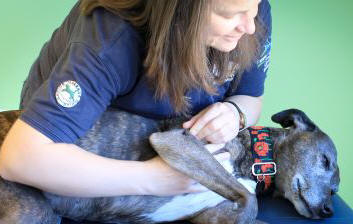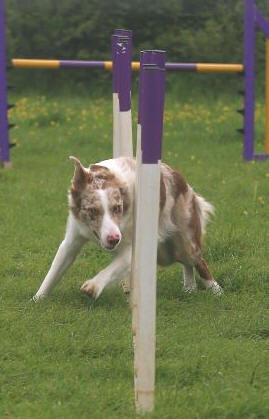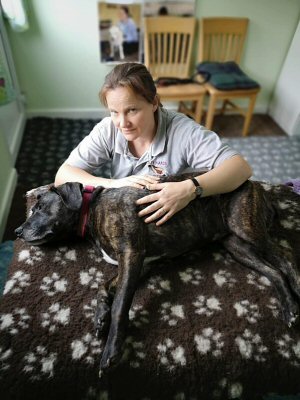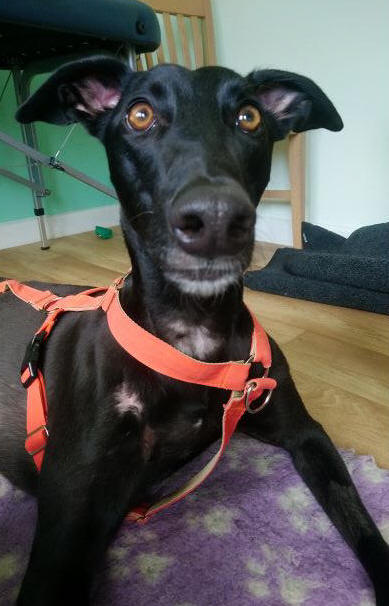| |
Is your
dog suffering in silence...
 Shoulder
injuries are especially common in agility dogs. The symptoms they present and
the severity of the injury can vary, making it difficult to identify the
problem. Canine massage therapist Karen Young details some of the signs that indicate that your dog may be carrying a shoulder injury. She offers
one therapeutic solution to help them get back on course. Shoulder
injuries are especially common in agility dogs. The symptoms they present and
the severity of the injury can vary, making it difficult to identify the
problem. Canine massage therapist Karen Young details some of the signs that indicate that your dog may be carrying a shoulder injury. She offers
one therapeutic solution to help them get back on course.
Our dogs
can dazzle us with their speed and control because they have highly mobile
shoulder joints which allows for a wide range of movement. But it is this
mobility that also makes them susceptible to injury. It is essential that, if an
injury is suspected, the appropriate care is given immediately to reduce the
risk of further damage and to support the healing process.
The main
causes of injuries in agility dogs include the things we commonly do in training
and while competing such as abrupt changes in direction, sudden stops, falls and
awkward landings and impacts with obstacles or other dogs which can cause the
shoulder to dislocate.
 How
to tell if your dog has injured its shoulder How
to tell if your dog has injured its shoulder
Signs will
vary between dogs depending upon the severity of the injury, but the most common
symptoms of a dislocated (luxated) shoulder are:-
-
Acute, sudden
lameness in one leg
-
Swelling and bruising
around the shoulder
-
Decreased movement
with the dog unable to fully extend or flex the affected leg
-
Signs of pain
including whining, whimpering, trying to exit the ring or displaying signs
of distress including ‘whale eyeing', licking the lips, shivering or
freezing in place
Happily
many dogs will not experience a full joint dislocation, but agility dogs are at
a higher risk of injury due to the repetitive actions in training and competition
which can
also lead to over-use injuries. Over time, small strains and sprains can cause the
shoulder joint to become less stable. This wouldn't be diagnosed as a luxation,
but any shoulder instability increases the risk of further damage and will
result in arthritic changes in the joint over time.
Here are
some things to look for in your dog that might indicate some instability and
pain in the shoulder joint:-
-
Intermittent or
persistent lameness which gets worse with exercise
-
Localised swelling
and touch sensitivity
-
Changes in posture to
reduce weight bearing on the affected limb
-
Difficulty standing
up from a down position
-
Choosing to lie down
on one side only with the unstable shoulder uppermost
-
Changes in the way
your dog lies down, particularly with a wide front leg position
-
Coat changes
including changes in directions, texture and sometimes colour
 Other
symptoms can be more subtle and may only show up when you are training or
competing and include:- Other
symptoms can be more subtle and may only show up when you are training or
competing and include:-
-
Consistently slower
times
-
Reluctance to weave,
coming out early or moving slower through them
-
Wider turns – usually
only in one direction
-
Falling onto the
inside shoulder on a turn – which would usually indicate an issue with the
outer shoulder
-
Reluctance to jump or
refusing to turn immediately on landing a jump
Diagnosis & treatment
If you suspect your dog has a shoulder injury,
the first step is to seek veterinary advice. In addition to a physical exam, the
veterinarian may need to organise imagines such as X-rays and CT scans.
 For a
shoulder injury in agility dogs, treatment typically involves: For a
shoulder injury in agility dogs, treatment typically involves:
-
Pain management - In most cases your vet will initially suggest
medications such as Metacam to alleviate pain and reduce inflammation. If
your dog has shoulder instability, the anti-inflammatory medications may
have no or limited benefit.
-
Rest and restricted activity - The body is designed to heal itself
and, for minor injuries, this can be extremely efficient so long as the
dog is able to rest. Avoid strenuous activities and prevent sudden movements
and direction changes to allow the joint to heal properly. This includes
preventing your dog jumping into and out of the car or accessing furniture.
If you haven't already done so, ensure all hard floors the dog accesses are covered with non-slip mats.
-
If dislocated - A closed reduction might be attempted. This involves
the veterinarian attempting to manipulate the joint back into its normal
position under anesthesia.
-
Surgery - May be required in severe or recurrent cases to stabilise
the joint and prevent further dislocations.
-
Rehabilitation - Once the initial rest phase has been completed, it
is sensible to start gently getting the dog back to fitness. Managed
exercise and clinical massage can speed up the recovery process, strengthen
the shoulder and prevent future injuries. Indeed, massage and gentle
exercise corrects* the body, thus allowing healing to take place.
*A note on
correction – any body, whether it be yours or your dogs - will
sub-consciously adjust how it moves to work around an injury. But if the
injury doesn't heal well or takes a bit of time, it can become fixed in this
new pattern of movement which can cause lameness and pain. It is for this
reason that I would recommend any dog that has suffered an injury has some
form of bodywork such as Clinical Massage as part of their rehabilitation.
As shoulder injuries
can vary in severity, the treatment will vary depending on each individual case.
Clinical Massage
and your injured dog
It's
important to note that massage therapy should be conducted by a
well-trained and experienced therapist. Your therapist should have a
good understanding of canine anatomy, proper techniques and use
precautions specific-to-shoulder injuries. This is where the Canine
Massage Guild comes in. All Guild therapists are fully trained, insured
and work to a code of ethics that means you can be confident in the
quality of support your dog will receive.
|
Whilst
Clinical Massage cannot ‘fix' a dislocated shoulder joint, here are some
of the ways it can aid in the overall recovery process:-
-
Pain Relief - Massage therapy
helps alleviate pain and discomfort around the affected joint, but
it can also relieve the pain in other parts of the body that are
working harder to allow the dog to continue moving around their
injury.
-
Reducing Swelling and Inflammation
- Massage techniques such as effleurage and lymphatic drainage
can reduce swelling and inflammation in the affected area, helping
to remove excess fluid which also provides pain relief.
-
Relaxation and Stress Reduction -
Injuries can cause stress and anxiety in dogs just like they do
in us. Massage therapy calms the mind, promotes relaxation and
increases the release of stress relieving hormones that help the
body to heal and the mind to become less worried.
-
Increasing Circulation -
Massage stimulates blood flow to the affected area, which delivers
essential nutrients, oxygen and the immune cells needed for tissue
repair and healing. Improved circulation also assists in removing
metabolic waste products and cellular debris which can be another
source of localised pain for your dog.
-
Promoting Range of Motion -
After the initial phase of healing, when the shoulder is stable and
the veterinarian approves, deeper, more focused massage techniques
and passive range of motion (stretching) can help gently mobilise
the joint and surrounding tissues. This reduces stiffness, improves
joint flexibility, and returns the body to pre-injury mobility.
-
Scar Tissue Management - As
the dog's recovery progresses, massage can help remodel the initial
scar tissue using gentle cross-fibre friction and myofascial
releases. Scars are initially very haphazard in the way the collagen
fibres are laid down as the initial priority is to ‘bridge' the
damage. Massage helps the collagen fibres in the scar tissue to
re-align with the surrounding undamaged tissue, improving tissue
flexibility and movement. Massage can also break down and reduce
adhesions (where tissues get stuck together) and increase
lubrication of the area making movement more comfortable.
|

This is William sporting scar tissue from a collision when running at
speed. Scar tissue is like an ice berg – what you see at the surface is
usually a fraction of the actual scar which will often run deep into the
tissues. |
Massage, like any
therapy, should be respectful to the dogs needs and pain levels. Your
therapist should be attentive to your dog's responses and work within
the dog's pain tolerance. Every session should be adjusted to meet the
current needs and so no two sessions look exactly the same.
In summary
Clinical Canine Massage can support the rehabilitation of shoulder
injuries by promoting pain relief, reducing swelling, enhancing circulation,
reducing stress and aiding in tissue healing. So to reduce the risk of shoulder
injury in your agility dogs, consider the following measures:-
-
Do proper warm-ups and stretching before intense exercise or
performances. Do not use a tug toy as your only warm up exercise.
-
Training and conditioning - There
are specific exercises that can help strengthen and build resilience and,
thereby, reduce injury risks.
-
Do not be tempted to train for too long
or too often - Many shoulder injuries occur as a result of repetitive or
excessive training.
- Technique and
handling - Focus on good handling, with and without the obstacles, as well
as good posture, core strength and body awareness. Remember a slower dog will
often win in the ring because they are more precise in their movement.
-
A good cool-down routine can ensure your dog recovers
faster after each training session and competitive run. It helps to flush the
hot tissue of metabolic waste material and any cellular debris, ensures the
tissues cool and return to resting tone effectively and reduces the risk of
post-exercise aches and pains.
-
Regular massage will help find and treat any areas of soreness or
small injuries which will prevent the dog subconsciously adjusting their
movement to work around such areas.
 About
the author... About
the author...
Karen
Young
is a member of the Canine Massage Guild. She runs Safe Hands Clinical Canine
Massage in Hemel Hempstead and also offers Canine Core Conditioning.
Before
setting up Safe Hands, she led international projects in Peru, Brazil, China and
the Middle East and ran European-wide schools programmes. She left this
successful career in 2014 and adopted her first lurcher that same year.
She
enrolled on the Canine Massage Therapy Centre’s two year Practitioner course and
the one year Canine Conditioning Academy’s Coach course. Safe Hands was
established in January 2017 and Karen has been supporting dogs and their owners
ever since.
She
adopted both her lurchers when volunteering at local rescue centres and has,
therefore, been banned from anymore volunteering as 'the house is not big enough
for any more dogs!'
You can find out more about Karen at
https://www.safehands.dog/uk
 About
the Canine Massage Guild... About
the Canine Massage Guild...
After 10 years, the Canine
Massage Guild continues to lead the way with a network of highly skilled
Clinical Canine Massage Therapists, based around the country. They specialise in
soft tissue rehabilitation and provide chronic pain management for orthopaedic
conditions.
In clinical trials with Winchester University which
studied the efficacy of the Lenton Method®, 95% of dogs responded
positively to clinical canine massage therapy, as published in Vet Record
by the British Veterinary
Association.
Available here[JY1] [JY2]
Providing results
you can see and your dog can feel!
Find your local Canine
Massage Guild therapist at
www.k9-massageguild.co.uk/therapistregister/
Photos:
Guild member images
First published 13th
October 2023
| |
|
 About
the author...
About
the author... About
the Canine Massage Guild...
About
the Canine Massage Guild...